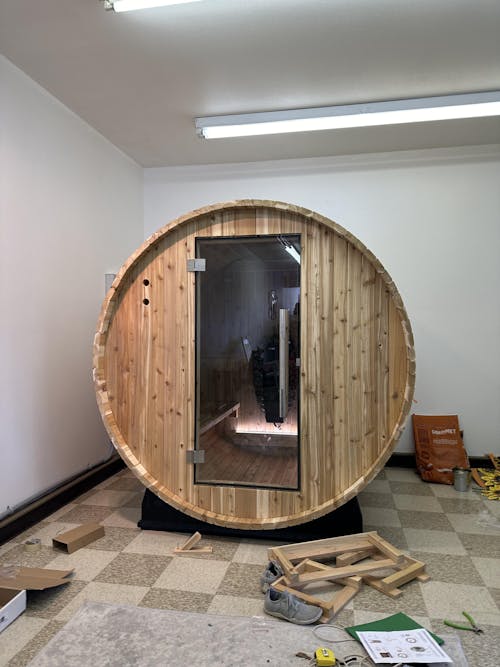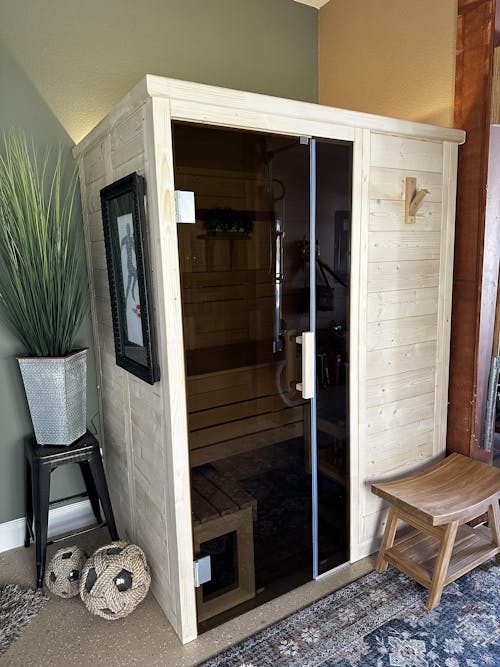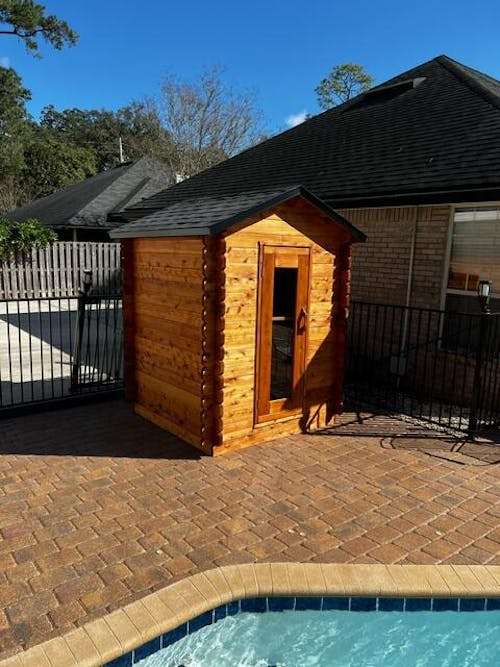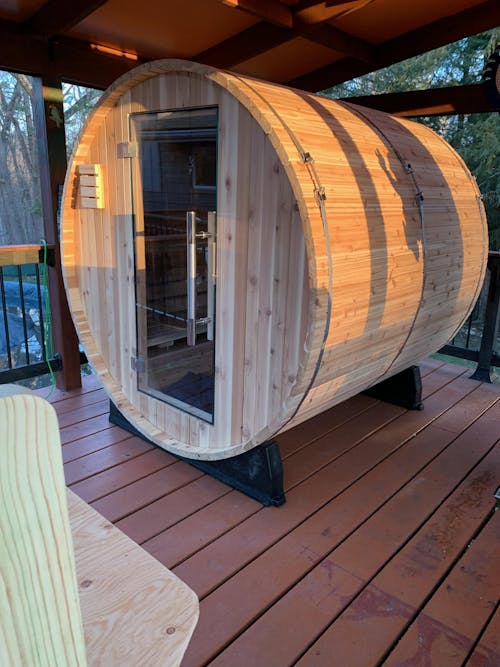WHAT IS A STEAM SAUNA?
ALL YOU NEED TO KNOW
Have you ever longed to unwind after a busy day or an intense workout, but the idea of soaking in a tub or taking a hot shower just doesn't hit the spot? If so, a steam sauna session might be just what you want.
Originating from the luxurious Roman bathhouses and culturally rich Turkish hammams, these steamy sanctuaries have not just survived but thrived across decades for their healing and therapeutic properties, from helping soothe sore muscles, improving circulation, and even clearing congestion.
What is a steam sauna? How do they work, and what benefits can you expect from using one? Keep reading to take a closer look at the ins and outs of steam saunas and how they can help you achieve your wellness goals.
What is a Steam Sauna and How Do They Work?
Also known as steam rooms or wet saunas, steam saunas are warm rooms with thick, billowing fog. These saunas are typically built with materials that can handle the high humidity and heat levels, such as non-porous tiles, glass, and acrylic. Such materials can help create a tight seal to prevent moisture from escaping while retaining heat.
At the heart of modern steam saunas are steam generators. These generators heat water to the boiling point, producing steam channeled straight into the sauna room. These steam rooms also feature adjustable vents, usually made of hemlock, that ensure proper ventilation to maintain optimal air quality, so you won't have to worry about breathing in stale, stinky air.
In traditional Finnish-style saunas or Korean dry saunas, löyly is an integral part of the experience. Löyly refers to pouring water onto the hot sauna stones that instantly vaporizes, creating a rush of steam that produces a refreshing, cleansing effect on the body and mind.
Steam saunas typically have a temperature range of 105 to 120 degrees Fahrenheit and a humidity level of a whopping 100%.
Steam Saunas vs. Dry Saunas
The moisture level is the biggest difference between a spa sauna steam room and a dry sauna. Steam saunas use steam generators like Mr.Steam MS-E Series, which creates a moist, often relaxing atmosphere. Steam rooms are also available as enclosed rooms, like the ones offered by Maya Bath Steam Showers. While the humidity level can soar up to 100%, the temperature usually hovers between 110 to 115 degrees Fahrenheit.
On the other hand, dry saunas (like the Almost Heaven Rainelle), commonly found in Finnish culture, rely on electric heaters or wood stoves to heat the room. In these dry saunas, the temperature is usually between 160 to 200 degrees Fahrenheit, while the humidity level is 10-20%. This dry heat helps sweat out impurities while offering potential muscle relaxation and stress relief.
Steam Saunas vs. Infrared Saunas
How does an infrared sauna fit into all this? Infrared saunas lie somewhere between dry and steam saunas, with humidity levels between 20 to 50 percent.
Infrared saunas (like Dynamic Saunas) come with infrared lamps emitting electromagnetic radiation. Research shows that these infrared rays can penetrate the muscles and tissues deep, promoting detoxification, relaxation, and even weight loss.
These saunas also operate at a lower temperature, ranging between 120 to 150 degrees Fahrenheit, making them an appealing option for those who can't tolerate the heat of traditional saunas or potentially feel claustrophobic in a steam room.



Benefits of Using Steam Saunas
Steam saunas offer several health benefits, including:
Improves Cardiovascular Health
Your heart pumps faster during a steam sauna to compensate for what your body releases. Research shows that this increases the amount of blood flowing throughout your system, which may help prevent cardiovascular disease and other chronic health conditions like high blood pressure and type 2 diabetes, explains UCLA Health.
Better Skin Health
A steam sauna session can work wonders for your skin health. When this soothing warm heat permeates your skin, it can help unclog your pores and release trapped sebum—an oily substance that can cause breakouts and inflammation so that you may have more clear, even-toned skin. Cleveland Clinic mentions that this can be especially beneficial for oily or acne-prone skin.
This increased blood flow during steam sauna has been shown to promote collagen and elastin production, keeping your skin firm, youthful and wrinkle-free.
Research also shows that sauna-induced sweat can improve the skin's permeability, allowing better absorption and efficacy of skincare products.
Sinus Relief
If you're tired of using over-the-counter medications, nasal sprays, and allergy drops, a steam sauna can help you breathe easier. A 2017 study published in the Indian Journal of Critical Care Medicine indicates that it when you breathe in moist air, it moisturizes airways and thins out mucus, offering much-needed relief for sinusitis and nasal congestion.
Beyond that, Medical News Today mentions that steam saunas offer exceptional respiratory health benefits, helping relieve the symptoms of allergies, colds, and flu.
Workout Recovery
One common after-effect of strenuous exercise is the delayed onset muscle soreness (DOMS), a feeling of discomfort and pain that typically begins 12 to 24 hours after a workout and can linger for a few days. If you are looking for a gentle way to accelerate recovery, a steam sauna can help.
Research shows that increased circulation during sauna sessions delivers vital nutrients and oxygen to your tired muscles, helping speed up recovery.
Stress Reduction
Stress can have detrimental effects on our health, leading to various issues such as digestive problems, heart complications, hypertension, and sexual dysfunction, notes Mayo Clinic. One way to cope with stress is using a steam sauna.
Research shows that when your body temperature increases during sauna bathing, your cortisol levels drop, alleviating the symptoms of stress and anxiety.
The high heat during steam sauna sessions also triggers the release of endorphins—the body's natural feel-good hormones. Healthline explains that these neurotransmitters help you feel happier and more relaxed so that you can take on the world with a positive attitude.
Loosens Stiff Joints
Prolonged sedentary periods, excessive physical exertion, and poor posture can all lead to joint stiffness. The good news is steam saunas can help.
The Arthritis Foundation notes that when your body acclimates to sauna temperatures, your blood vessels expand. Studies show that this vasodilation process stimulates nutrient delivery and helps flush out metabolic waste, alleviating inflammation and joint stiffness.
A 2013 study also found that heat therapy significantly enhanced muscle and connective tissue flexibility. This improved flexibility can help reduce joint stress and increase your range of motion and physical performance. This can be especially beneficial for athletes and those leading an active lifestyle.
Promotes Weight Loss
If you want to shed a few pounds without racing through the block or hopping on the treadmill, consider steam sauna bathing for weight loss. During a steam sauna session, your body works harder to lower its core temperature.
Harvard University explains that this process accelerates your metabolic rate, helping you burn more calories and fat.



Safety Precautions While Using Steam Sauna
Here are the preventive measures you should remember to ensure a safe and enjoyable steam sauna experience:
-
Like any activity that makes you sweat, steam saunas can dehydrate you, leading to lethargy, dizziness, or even fainting. To prevent this, it's important you stay well hydrated. Drink plenty of water before you step into the sauna, continue to sip during your session, and rehydrate with an electrolyte-rich drink once you're done. Don't drink alcohol, though, as it can affect your blood pressure and heart rate.
-
When it comes to your attire inside the steam sauna, less is more. Wear lightweight, loose-fitted garments that allow your skin to breathe and don't stick to it. Avoid synthetic materials like polyester or nylon, as they will likely trap heat and prevent your body from cooling down properly.
-
Steam saunas tend to be damp and slippery. It's essential to wear non-slip flip-flops or sandals inside the sauna to prevent any slip-and-fall accidents.
-
Since overstaying in a sauna can cause overheating or even heat exhaustion, it's important to keep sessions under 15-20 minutes and never exceed 30 minutes, even if you're a seasoned sauna-goer.
-
If you start to feel dizzy, lightheaded, or uncomfortable at any point, that's your signal to take a break and step out.
-
Don't rush off to your next task after taking a sauna bath. Instead, give your body a chance to adjust back to normal temperatures by drinking water, taking a cool shower, and resting for 15-20 minutes.
-
A hot, wet environment can be a breeding ground for bacteria. Make sure to clean the sauna regularly to maintain optimal hygiene.
-
Bring a towel to sit on and another one to wrap around yourself. You might feel more comfortable with a towel around your body, especially if you're sharing the sauna with strangers. Also, you definitely don't want to sit directly on the bench; that's just gross!
-
Take a shower before you enter the sauna. You don't want to bring any dirt or sweat into the steamy room. Plus, it will help your pores open up and prepare for the sauna. Make sure to skip the lotion or cream, as they can clog your skin.
Tips for Choosing a Steam Sauna
Here are some tips to help you find the best steam sauna for your home.
-
First, decide whether you want an indoor or outdoor steam sauna. This will depend on your space, budget, and personal preference. Indoor saunas are more compact and convenient, but outdoor saunas offer more variety and authenticity. If you're looking for something traditional and rustic, you might want to go for a wood-burning sauna, but remember that they are only for outdoor use.
-
Think about the size and capacity of your sauna. How many people will be using it at once? Do you want a cozy one-person sauna or a spacious one that can fit your whole family? Saunas come in different sizes, from one to eight person capacities. Make sure you measure the dimensions of the space where you want to install your sauna and choose one that fits comfortably.
-
Consider the type of wood that your sauna is made of. Different woods have different properties, such as resistance to splitting and shrinking, aroma, color, and texture. Cedar is popular for saunas because it is durable, aromatic, and beautiful. However, it is also more expensive than other woods. Spruce and pine are cheaper alternatives that are also suitable for saunas. Avoid plywood or any wood that contains glues or chemicals that can outgas in high temperatures.
-
Finally, think about the extras that you want in your sauna. Do you want to customize it with accessories like light therapy, aromatherapy, audio system, or entertainment options? Do you want a sauna with a timer, a thermometer, a vent, or a window? Do you want a carbon or ceramic heater? Carbon heaters are thinner, lighter, safer, and last longer than ceramic heaters, but are also more costly. These features can help enhance your comfort and safety in the sauna.
There you have it! Another tip is to always remember to always check your sauna's warranty and safety before buying it.



Steam Saunas: FAQs
Which Is Better: A Dry Sauna or a Steam Room?
Deciding whether a dry sauna or steam room is better largely depends on personal preference and individual health needs. A dry sauna might be the better option if you want to boost your heart health, improve circulation, ease joint and muscle pains, or just seek deeper relaxation.
Conversely, a steam room may be more beneficial if you want to improve your skin's appearance, detoxify your body, or improve your respiratory health.
Is a Steam Sauna Good for You?
Absolutely! Steam saunas can help improve cardiovascular health, lower stroke risk, ease bronchitis symptoms, boost the immune system, loosen stiff joints, and relieve muscle soreness after a strenuous workout (via WebMD).
How Many Calories Do You Burn in a Steam Room?
The amount of calories you burn in a steam room will depend on your fitness level and the time spent there. Generally, a 20-minute steaming session will burn around 100 to 150 calories.
What Is the Side Effect of Steam Saunas?
While steam saunas are a safe and healthy way to get your sweat on, but they have some side effects. Some people may experience hot flashes, dizziness, or headaches while using them. Research also shows that high humidity may cause itching, especially if you're suffering from atopic dermatitis.
Steam saunas can also cause overheating and dehydration, so drinking plenty of water before and after using them is important.
Is It Ok To Use a Steam Sauna Every Day?
Yes, you can use a steam sauna daily if you follow necessary safety precautions and do not exceed a session beyond 20 minutes.
If you have any pre-existing medical conditions like heart disease, hypertension, or diabetes, consult your healthcare provider before incorporating a steam sauna into your fitness regimen. Pregnant women or those taking prescription medicines that affect the nervous system should also exercise caution.



What is a Steam Sauna?: The Takeaway
Whether you're looking for a quick rejuvenation, deep pain relief, or improving your heart health, a steam sauna session is all you need. To maximize your steam sauna experience, ensure you're well-hydrated, limit your time to 15-20 minutes to avoid dehydration, and listen to your body.
If you want to transform your home into a personal wellness oasis, check out MySaunaWorld's impressive collection of traditional and infrared saunas. For more information on our models or any queries, feel free to contact us, and our friendly staff will be happy to assist.
SIGN UP. SAVE BIG.
Subscribe to be the first to know about our special monthly sauna sales, sent right to your inbox.

About the Author
Adam Fromson
Adam Fromson, co-founder of My Sauna World, loves saunas and their transformative health benefits. With years of experience exploring sauna culture and its impact on health and wellness, Adam is passionate about helping others discover the life-changing benefits of saunas for themselves.
Let customers speak for us
from 385 reviews
Good communication, easy delivery, easy set up, easy operation, great value. Recommended!

We ordered the 4 person barrel sauna and love it! We wanted a little extra space for the 2 of us/guests and it’s great. We could definitely fit 4 people in it if we needed. We use it every single day. It took about 10 weeks to get here because they build it specifically for the order. Putting the barrel together was fairly easy with 2 people. The electrical and the heater definitely required an electrician to install as we could have not done it alone.
We ordered the biggest heater (harvia spirit 8kw) and it heats up the sauna in about 15 mins inside our 40-50° garage. Overall this style of sauna is hotter and you sweat a lot faster than in an infrared sauna. I truly 10/10 recommend!
Pic is of us in the middle of building it.

Took me about 6 hours over 2 evenings to assemble almost all by myself. Had a pro run a new circuit from my panel. Very well made and assembly was straightforward. Heater is well sized and reaches operating temperature in under 30 minutes.

Great sauna very easy to assemble

The salt panel was a great addition to our Madison Sauna. It has excellent grain which is accented by the amazing color lights that glow through the panel. Also when you hit the rocks with a splash of water you can feel the heat bounce off the panel. Great addition if you are considering this option.

We can say enough about Sauna World there customer support is great! Our Pinnacle Sauna from Almost Heaven is epic.

The finish and quality is outstanding and it was quick and easy to assemble.

We are thrilled with our mini pod!! It came well shipped and our friend assembled it in 11 hours! Wow! We cannot wait to get healthy and sauna it up!

Beautiful sauna!!! Much easier than I expected to assemble, took a total of 4 hours. Can't wait to get warm by the pool on those cool evenings. Customer service was excellent..

Purchased a 2 person Almost Heaven barrel sauna and were delighted with the product. The order process was quick and easy, the sauna arrived on-time, installation was simple, following the provided instructions, and the sauna is extremely high quality. We’ve used it daily for over 2 weeks and quite frankly I don’t know how we lived without it. If I had it to do over again I wouldn’t change a thing... except maybe purchasing a 4 person model to easier share with friends!

Great Customer Service and a breeze to put together.Excellent shipping and the Sauna is top notch, couldn’t be happier






























